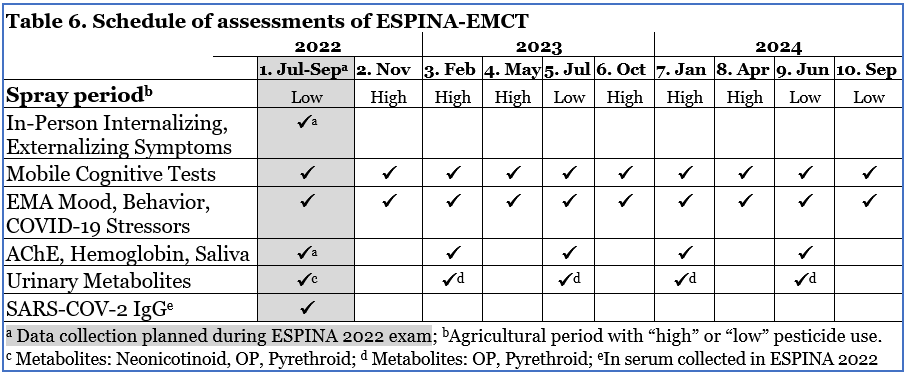RESEARCH PROJECTS
(PI: Briana Chronister) 7/1/2025 – 6/31/2026
“Integrating Mobility to Enhance Pesticide Exposure Measurement within the ESPINA-EMCT Study.”
This study builds upon the ESPINA-EMCT study by incorporating location tracking of participants using the same smartphone devices employed for ecological momentary cognitive testing in 2024. Commonly used geospatial proxies of pesticide exposure, like stationary home surface area of agricultural fields, potentially introduces misclassification bias by ignoring individuals’ mobility patterns. By integrating ESPINA-EMCT participant movement data with publicly accessible data, we aim to assess whether accounting for participant mobility improves characterization of pesticide exposure potential based on proximity to sites where pesticides are used (e.g. agricultural crops). Location tracking data will enable us to account for each individual’s time spent near or far from pesticide spray sites during the study period, potentially improving the accuracy of geospatial constructs of pesticide exposure. Findings from this project will help improve environmental exposure measurement that can be used in agricultural communities both within and beyond Pedro Moncayo.
1RO1ES025792 NIH/NIEHS (PI: Suarez, JR, Moore, R) 2022-2027
“Cyclical alterations in neurocognitive performance and mood over two years in relation to pesticide spray seasons among adolescent and young adult participants of the ESPINA study. ”
This project builds on the ESPINA study 2022 examination and proposes to assess whether pesticide spray seasons are associated with cyclical alterations in mental health symptoms and cognitive performance assessed over two years using a smartphone-based assessment platform, and to test whether pesticide exposure biomarkers are related to elevated depressive and externalizing symptoms and decreased cognitive performance.
- Pesticide Spray Seasons
- How much pesticide exposure variability in metabolites?
- Transiently Affect
- Cognitive performance?
- Internalizing / Externalizing behaviors
- Long Term Associations
- Internalizing / Externalizing behaviors

1025804 (MPI: D. Tamayo-Murillo, JR Suarez) 6/1/22 – 5/1/25
Oncoustics Inc. and UCSD, H. Wertheim School of Public Health
“PFAS, pesticides and hepatic steatosis and thyroid nodules of young adults within the ESPINA study”
This ancillary study to the 2022 follow-up examination of the study of Secondary Pesticide Exposures among Children and Adolescents (ESPINA) aims at understanding the health effects of perfluoro alkyl substances (PFAS) and fungicides on liver steatosis, fibrosis and thyroid size evaluated using ultrasound in young adults.
R01ES030378 NIH/NIEHS (PI: Suarez, JR) 2020 – 2025
“The 2022 ESPINA study follow-up Exam: Fungicides, Insecticides, Inflammation and Child Development”
This project involves the 12-year follow-up of participants of the Study of Secondary Exposure among Children and Adolescents (ESPINA study). The major goals of this project are to determine the longitudinal associations of sub-clinical exposures to fungicides and insecticides with inflammatory markers (vascular, monocyte, systemic and liver) and cognition among adolescent participants living in agricultural communities in Ecuador as part of the longitudinal “Secondary Pesticide Exposures among Children and Adolescents” (ESPINA) study.
- Insecticides: OPs, Neonicotinoids, Pyrethroids
- Inflammation Markers
- CRP, TNFa, IL-6, sCD14, sICAM-1, sVCAM-1
- Inflammation Markers
- Fungicides: Azoles, ETU
- Liver Inflammation with respect to AST, ALT, Cytokeratin 18 [m30, m56 fractions)
- Pesticides with respect to cognitive performance
K01 ES031697 NIH/NIEHS (PI: Kayser, G) 2020-2025
“Pesticide exposures, mental health and endocrine disruption among children growing up near pesticide spray sites (ESPINA study).”
This training grant within the ESPINA study is aimed at characterizing the geospatial determinants of pesticide exposure, mental health and endocrine disruption among participants living within agricultural settings in which pesticides are used. Additionally, it will aim to measure neonicotinoid insecticides in water collected at various places within these communities.
- Geospatial determinants of pesticide exposure
- Urinary Metabolites (insecticides, herbicides)
- Geospatial determinants of health
- Neurobehavior
- Anxiety and Depression
- Hormones (Sex and Adrenal)
- Water contamination pilot (~ 150 samples)
- Neonicotinoids
- Clorine, organic carbon, fluoride, metals (copper, zinc, lead)
- Microbiological (total and fecal coliforms)
CHEAR 2018-1599, U2CES026560, U2CES026533, U2CES026555
(PIs: JR Suarez, DP Jones, DB Barr, L Peterson, C Gennings) 6/2019-6/2023
NIEHS/Children’s Health Exposure Analysis Resource (CHEAR)
“Pesticides, Perfluorinated Compounds, and the Development of Adolescents in Agricultural Communities”
- PFAS
- Externalizing behaviors with respect to BMI for age and adiposity
- Glyphosate, ETU
- Metabolomics
- To identify endogenous metabolites and metabolic pathways associated with exposure to neonicotinoids, dithiocarbamates and PFAS
R01ES025792 NIH/NIEHS (PI: Suarez, JR) 2016-2021
“The ESPINA Study Follow-up Examination in 2016: Environmental Pollutants and Child/Adolescent Development”
The major goals of this project are to determine the longitudinal associations of sub-clinical exposures to pesticides with child development among participants living in agricultural communities in Ecuador as part of the longitudinal “Secondary Pesticide Exposures among Children and Adolescents” (ESPINA) study.
R21ES026084 NIH/NIEHS (PI: Suarez, JR) 2015-2018
“Pesticides and Mental Health among Adolescents in Ecuadorian Agricultural Communities”
The major goals of this project are to determine the relations of sub-clinical exposures to pesticides with mental health outcomes including school performance, aggression and impulsive symptoms among adolescents living in agricultural communities in Pedro Moncayo County, Ecuador. Additionally, this investigation aims at strengthening an epidemiologic information system of Pedro Moncayo County collected through community participation.
FPMH (PI: Suarez, JR) 2014-2015
Department of Family and Preventive Medicine Pilot Grant Program UC San Diego, USA
“Environmental Pollutants, Anxiety and Depression in Adolescents”
R36 OH009402 NIOSH (PI: Suarez, JR) 2007-2009
Effects of Secondary Occupational Pesticide Exposure on Childhood Growth and Neurobehavioral Development (ESPINA Study), University of Minnesota, Minneapolis, USA
ACADEMIC GRANTS
Interns Program, Global Health Institute, University of California San Diego 2016-2017
“Interns Program in Quito, Ecuador: Field work experience for Academic Health Center students within NIH funded Environmental Health Studies in Ecuador”
Abbreviations:
NIH: National Institutes of Health, USA
NIEHS: National Institute of Environmental Health Sciences, USA
CDC: Centers for Disease Control, USA
NIOSH: National Institute of Occupational Safety and Health, USA
PI: Principal Investigator
